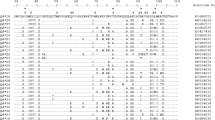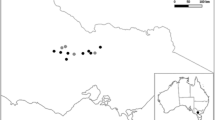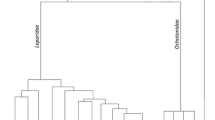Abstract
The European rabbit (Oryctolagus cuniculus) is used as a model for many human diseases, yet comparatively little is known of its genetics, particularly at important loci such as the major histocompatibility complex (MHC). This study investigated genetic diversity and evolutionary history of the DQA gene in a range of leporid species by analysing coding sequence diversity of exon 2 and intron 2 in 53 individuals of 16 different species. Fifty leporid DQA alleles were detected, including 13 novel European rabbit alleles. In the rabbit, the highest levels of diversity were observed in wild rabbits from Portugal, with wild rabbits from England and domestic rabbits showing less diversity. Within the sample, several recombination events were detected and trans-specific evolution of alleles was evidenced, both being general characteristics of mammalian MHC genes. Positive selection is implicated as operating on six codons within exon 2, which are also subject to positive selection in other mammals. Some of these positions are putative antigen recognition sites and underline the importance of pathogen-driven selection on these MHC genes.




Similar content being viewed by others
References
Andersson L, Rask L (1988) Characterization of the MHC class II region in cattle. The number of DQ genes varies between haplotypes. Immunogenetics 27:110–120 doi:10.1007/BF00351084
Apanius V, Penn D, Slev PR, Ruff LR, Potts WK (1997) The nature of selection on the major histocompatibility complex. Crit Rev Immunol 17:179–224
Berggren KT, Ellegren H, Hewitt GM, Seddon JM (2005) Understanding the phylogeographic patterns of European hedgehogs, Erinaceus concolor and E. europaeus using the MHC. Heredity 95:84–90 doi:10.1038/sj.hdy.6800694
Bielawski JP, Yang Z (2003) Maximum likelihood methods for detecting adaptive evolution after gene duplication. J Struct Funct Genomics 3:201–212 doi:10.1023/A:1022642807731
Branco M, Ferrand N, Monnerot M (2000) Phylogeography of the European rabbit (Oryctolagus cuniculus) in the Iberian Peninsula inferred from RFLP analysis of the cytochrome b gene. Heredity 85(Pt 4):307–317 doi:10.1046/j.1365-2540.2000.00756.x
Bryja J, Galan M, Charbonnel N, Cosson JF (2006) Duplication, balancing selection and trans-species evolution explain the high levels of polymorphism of the DQA MHC class II gene in voles (Arvicolinae). Immunogenetics 58:191–202 doi:10.1007/s00251-006-0085-6
Doherty PC, Zinkernagel RM (1975) A biological role for the major histocompatibility antigens. Lancet 1:1406–1409 doi:10.1016/S0140-6736(75)92610-0
Dubiski S (1969) Immunochemistry and genetics of a “new” allotypic specificity Ae14 of rabbit gamma-G immunoglobulins: recombination in somatic cells. J Immunol 103:120–128
Esteves PJ, Lanning D, Ferrand N, Knight KL, Zhai SK, van der Loo W (2004) Allelic variation at the VHa locus in natural populations of rabbit (Oryctolagus cuniculus, L.). J Immunol 172:1044–1053
Esteves PJ, Lanning D, Ferrand N, Knight KL, Zhai SK, van der Loo W (2005) The evolution of the immunoglobulin heavy chain variable region (IgVH) in Leporids: an unusual case of transspecies polymorphism. Immunogenetics 57:874–882 doi:10.1007/s00251-005-0022-0
Fain MA, Zhao T, Kindt TJ (2001) Improved typing procedure for the polymorphic single-copy RLA-DQA gene of the rabbit reveals a new allele. Tissue Antigens 57:332–338 doi:10.1034/j.1399-0039.2001.057004332.x
Geraldes A, Ferrand N, Nachman MW (2006) Contrasting patterns of introgression at X-linked loci across the hybrid zone between subspecies of the European rabbit (Oryctolagus cuniculus). Genetics 173:919–933 doi:10.1534/genetics.105.054106
Gu X, Nei M (1999) Locus specificity of polymorphic alleles and evolution by a birth-and-death process in mammalian MHC genes. Mol Biol Evol 16:147–156
Hasegawa M, Kishino H, Yano T (1985) Dating of the human-ape splitting by a molecular clock of mitochondrial DNA. J Mol Evol 22:160–174 doi:10.1007/BF02101694
Hermel E, Han M, Hague B, Kindt T, Monaco JJ (1999) Isolation and mapping of the rabbit DM genes. Immunogenetics 49:295–302 doi:10.1007/s002510050496
Hughes AL, Nei M (1990) Evolutionary relationships of class II major-histocompatibility-complex genes in mammals. Mol Biol Evol 7:491–514
Klein J, Figueroa F (1986) Evolution of the major histocompatibility complex. Crit Rev Immunol 6:295–386
Klein J, Satta Y, Takahata N, O'HUigin C (1993) Trans-specific Mhc polymorphism and the origin of species in primates. J Med Primatol 22:57–64
Kulaga H, Sogn JA, Weissman JD, Marche PN, LeGuern C, Long EO et al (1987) Expression patterns of MHC class II genes in rabbit tissues indicate close homology to human counterparts. J Immunol 139:587–592
Lawlor DA, Ward FE, Ennis PD, Jackson AP, Parham P (1988) HLA-A and B polymorphisms predate the divergence of humans and chimpanzees. Nature 335:268–271 doi:10.1038/335268a0
LeGuern C, Marche PN, Kindt TJ (1985) Molecular evidence for five distinct MHC class II alpha genes in the rabbit. Immunogenetics 22:141–148 doi:10.1007/BF00563511
Matthee CA, van Vuuren BJ, Bell D, Robinson TJ (2004) A molecular supermatrix of the rabbits and hares (Leporidae) allows for the identification of five intercontinental exchanges during the Miocene. Syst Biol 53:433–447 doi:10.1080/10635150490445715
Maydt J, Lengauer T (2006) Recco: recombination analysis using cost optimization. Bioinformatics 22:1064–1071 doi:10.1093/bioinformatics/btl057
Nielsen R, Yang Z (1998) Likelihood models for detecting positively selected amino acid sites and applications to the HIV-1 envelope gene. Genetics 148:929–936
Nizetic D, Figueroa F, Dembic Z, Nevo E, Klein J (1987) Major histocompatibility complex gene organization in the mole rat Spalax ehrenbergi: evidence for transfer of function between class II genes. Proc Natl Acad Sci U S A 84:5828–5832 doi:10.1073/pnas.84.16.5828
Norimine J, Brown WC (2005) Intrahaplotype and interhaplotype pairing of bovine leukocyte antigen DQA and DQB molecules generate functional DQ molecules important for priming CD4(+) T-lymphocyte responses. Immunogenetics 57:750–762 doi:10.1007/s00251-005-0045-6
Oliver MK, Piertney SB (2006) Isolation and characterization of a MHC class II DRB locus in the European water vole (Arvicola terrestris). Immunogenetics 58:390–395
Oudin J (1960) Allotypes of certain serum protein antigens. Immuno-chemical and genetic relationships between 6 principal allotypes observed in rabbit serum. C R Hebd Seances Acad Sci 250:770–772
Queney G, Vachot AM, Brun JM, Dennebouy N, Mulsant P, Monnerot M (2002) Different levels of human intervention in domestic rabbits: effects on genetic diversity. J Heredity 93:205–209 doi:10.1093/jhered/93.3.205
Robinson T, Matthee C (2005) Phylogeny and evolutionary origins of the Leporidae: a review of cytogenetics, molecular analyses and a supermatrix analysis. Mammal Rev 35:231–247 doi:10.1111/j.1365-2907.2005.00073.x
Salmon J, Nonnenmacher M, Caze S, Flamant P, Croissant O, Orth G et al (2000) Variation in the nucleotide sequence of cottontail rabbit papillomavirus a and b subtypes affects wart regression and malignant transformation and level of viral replication in domestic rabbits. J Virol 74:10766–10777 doi:10.1128/JVI.74.22.10766-10777.2000
Seddon JM, Baverstock PR (1999) Variation on islands: major histocompatibility complex (Mhc) polymorphism in populations of the Australian bush rat. Mol Ecol 8:2071–2079 doi:10.1046/j.1365-294x.1999.00822.x
Sittisombut N, Knight KL (1986) Rabbit major histocompatibility complex. I. Isolation and characterization of three subregions of class II genes. J Immunol 136:1871–1875
Surridge AK, Mundy NI (2002) Trans-specific evolution of opsin alleles and the maintenance of trichromatic colour vision in Callitrichine primates. Mol Ecol 11:2157–2169 doi:10.1038/sj.hdy.6885110
Surridge AK, Bell DJ, Ibrahim KM, Hewitt GM (1999) Population structure and genetic variation of European wild rabbits (Oryctolagus cuniculus) in East Anglia. Heredity 82(Pt 5):479–487 doi:10.1046/j.1365-294X.2002.01597.x
Swanson WJ, Wong A, Wolfner MF, Aquadro CF (2004) Evolutionary expressed sequence tag analysis of Drosophila female reproductive tracts identifies genes subjected to positive selection. Genetics 168:1457–1465 doi:10.1534/genetics.104.030478
Swofford DL (2003) PAUP*. Phylogenetic analysis using parsimony (*and other methods), version 4. Sinauer Associates, Sunderland, Massachusetts
Takahashi K, Rooney AP, Nei M (2000) Origins and divergence times of mammalian class II MHC gene clusters. J Heredity 91:198–204 doi:10.1093/jhered/91.3.198
Takahata N, Nei M (1990) Allelic genealogy under overdominant and frequency-dependent selection and polymorphism of major histocompatibility complex loci. Genetics 124:967–978
Trowsdale J (1995) “Both man & bird & beast”: comparative organization of MHC genes. Immunogenetics 41:1–17 doi:10.1007/BF00188427
van der Loo W, Bouton CE, Sanchez M, Mougel F, Castien E, Hamers R et al (1995) Characterization and DNA sequence of the b6w2 allotype of the rabbit immunoglobulin kappa 1 light chain (b locus). Immunogenetics 42:333–341
van der Loo W, Mougel F, Bouton C, Sanchez MS, Monnerot M (1999) The allotypic patchwork pattern of the rabbit IGKC1 allele b5wf: genic exchange or common ancestry. Immunogenetics 49:7–14 doi:10.1007/s002510050458
Wong WS, Yang Z, Goldman N, Nielsen R (2004) Accuracy and power of statistical methods for detecting adaptive evolution in protein coding sequences and for identifying positively selected sites. Genetics 168:1041–1051 doi:10.1534/genetics.104.031153
Yang Z (1997) PAML: a program package for phylogenetic analysis by maximum likelihood. Comput Appl Biosci 13:555–556
Yang Z, Bielawski JP (2000) Statistical methods for detecting molecular adaptation. Trends Ecol Evol 15:496–503 doi:10.1016/S0169-5347(00)01994-7
Yang Z, Nielsen R, Goldman N, Pedersen AM (2000) Codon-substitution models for heterogeneous selection pressure at amino acid sites. Genetics 155:431–449
Yang Z, Wong WS, Nielsen R (2005) Bayes empirical Bayes inference of amino acid sites under positive selection. Mol Biol Evol 22:1107–1118 doi:10.1093/molbev/msi097
Yuhki N, Beck T, Stephens RM, Nishigaki Y, Newmann K, O'Brien SJ (2003) Comparative genome organization of human, murine, and feline MHC class II region. Genome Res 13:1169–1179 doi:10.1101/gr.976103
Acknowledgements
A.K.S was funded by a Wellcome Trust Training Fellowship. W.vdLoo was funded by the Belgian Foundation for Scientific Research (NFWO-V). This work was also supported by the Foundation for Science and Technology Portugal: grants SFRH/BD/31048/2006, SFRH/BPD/27021/2006, SFRH/BD/xxxxx/200x to J.A., P.J.E., M.C., respectively. We are grateful to Michelle Fain for interesting discussions.
Author information
Authors and Affiliations
Corresponding author
Rights and permissions
About this article
Cite this article
Surridge, A.K., van der Loo, W., Abrantes, J. et al. Diversity and evolutionary history of the MHC DQA gene in leporids. Immunogenetics 60, 515–525 (2008). https://doi.org/10.1007/s00251-008-0309-z
Received:
Accepted:
Published:
Issue Date:
DOI: https://doi.org/10.1007/s00251-008-0309-z




